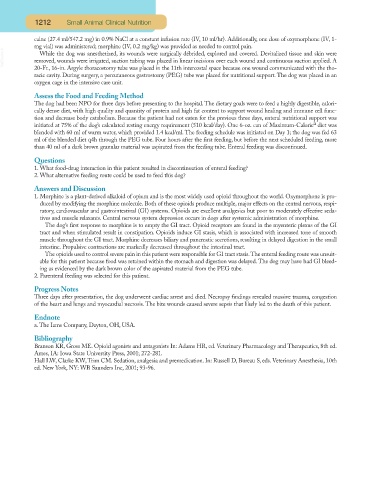Page 1164 - Small Animal Clinical Nutrition 5th Edition
P. 1164
1212 Small Animal Clinical Nutrition
caine (27.4 ml/547.2 mg) in 0.9% NaCl at a constant infusion rate (IV, 10 ml/hr). Additionally, one dose of oxymorphone (IV, 1-
mg vial) was administered; morphine (IV, 0.2 mg/kg) was provided as needed to control pain.
VetBooks.ir removed, wounds were irrigated, suction tubing was placed in linear incisions over each wound and continuous suction applied. A
While the dog was anesthetized, its wounds were surgically débrided, explored and covered. Devitalized tissue and skin were
20-Fr., 16-in. Argyle thoracostomy tube was placed in the 11th intercostal space because one wound communicated with the tho-
racic cavity. During surgery, a percutaneous gastrostomy (PEG) tube was placed for nutritional support. The dog was placed in an
oxygen cage in the intensive care unit.
Assess the Food and Feeding Method
The dog had been NPO for three days before presenting to the hospital. The dietary goals were to feed a highly digestible, calori-
cally dense diet, with high quality and quantity of protein and high fat content to support wound healing and immune cell func-
tion and decrease body catabolism. Because the patient had not eaten for the previous three days, enteral nutritional support was
a
initiated at 75% of the dog’s calculated resting energy requirement (510 kcal/day). One 6-oz. can of Maximum-Calorie diet was
blended with 60 ml of warm water, which provided 1.4 kcal/ml. The feeding schedule was initiated on Day 1; the dog was fed 63
ml of the blended diet q4h through the PEG tube. Four hours after the first feeding, but before the next scheduled feeding, more
than 40 ml of a dark brown granular material was aspirated from the feeding tube. Enteral feeding was discontinued.
Questions
1. What food-drug interaction in this patient resulted in discontinuation of enteral feeding?
2. What alternative feeding route could be used to feed this dog?
Answers and Discussion
1. Morphine is a plant-derived alkaloid of opium and is the most widely used opioid throughout the world. Oxymorphone is pro-
duced by modifying the morphine molecule. Both of these opioids produce multiple, major effects on the central nervous, respi-
ratory, cardiovascular and gastrointestinal (GI) systems. Opioids are excellent analgesics but poor to moderately effective seda-
tives and muscle relaxants. Central nervous system depression occurs in dogs after systemic administration of morphine.
The dog’s first response to morphine is to empty the GI tract. Opioid receptors are found in the myenteric plexus of the GI
tract and when stimulated result in constipation. Opioids induce GI stasis, which is associated with increased tone of smooth
muscle throughout the GI tract. Morphine decreases biliary and pancreatic secretions, resulting in delayed digestion in the small
intestine. Propulsive contractions are markedly decreased throughout the intestinal tract.
The opioids used to control severe pain in this patient were responsible for GI tract stasis.The enteral feeding route was unsuit-
able for this patient because food was retained within the stomach and digestion was delayed. The dog may have had GI bleed-
ing as evidenced by the dark brown color of the aspirated material from the PEG tube.
2. Parenteral feeding was selected for this patient.
Progress Notes
Three days after presentation, the dog underwent cardiac arrest and died. Necropsy findings revealed massive trauma, congestion
of the heart and lungs and myocardial necrosis. The bite wounds caused severe sepsis that likely led to the death of this patient.
Endnote
a. The Iams Company, Dayton, OH, USA.
Bibliography
Branson KR, Gross ME. Opioid agonists and antagonists In: Adams HR, ed. Veterinary Pharmacology and Therapeutics, 8th ed.
Ames, IA: Iowa State University Press, 2001; 272-281.
Hall LW, Clarke KW,Trim CM. Sedation, analgesia and premedication. In: Russell D, Bureau S, eds. Veterinary Anesthesia, 10th
ed. New York, NY: WB Saunders Inc, 2001; 93-96.

